Classic Filipino Pork Adobo is both easy and delicious! A great way to use that pork shoulder or pork butt. Ready in just 90 minutes, too.
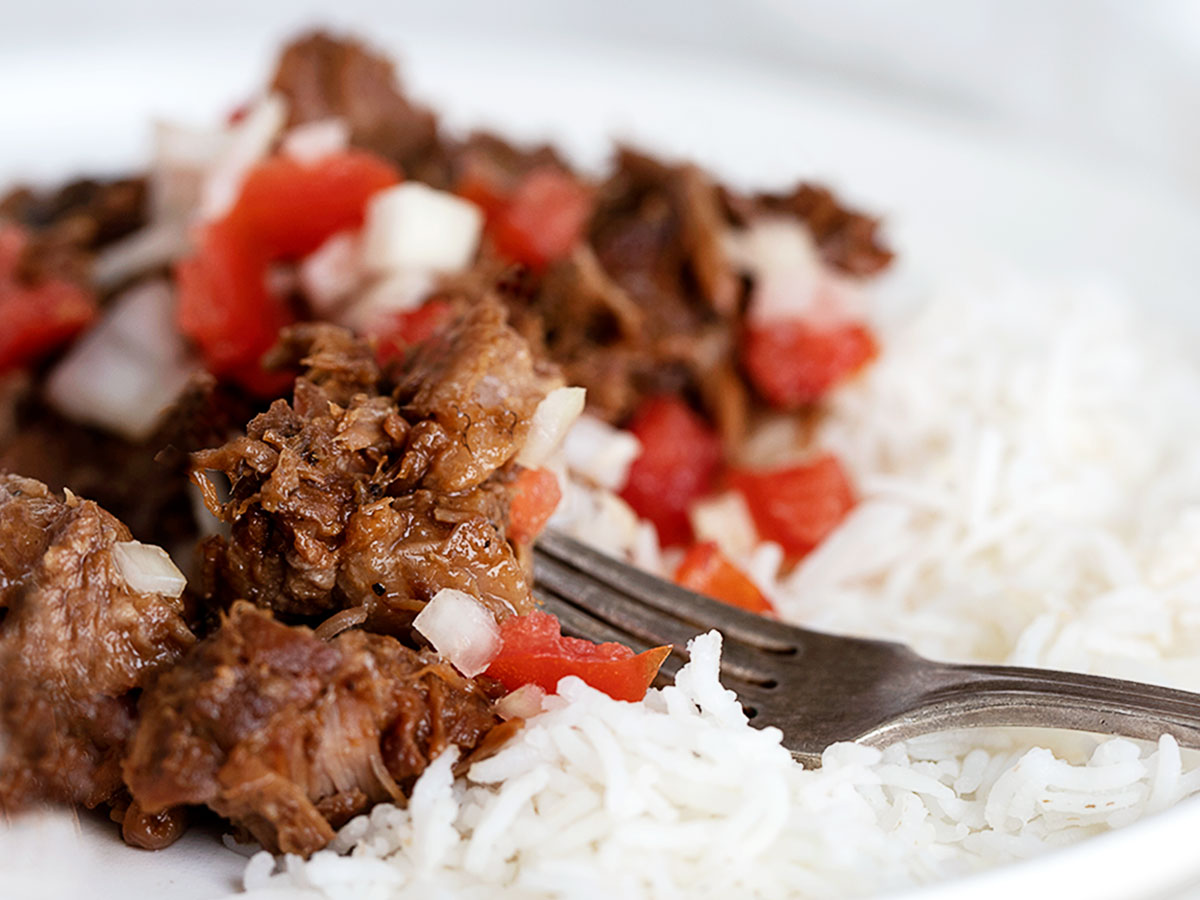
This Classic Filipino Pork Adobo recipe is “what else to do with that pork shoulder” beyond pulled pork :) This simple slow cooked pork dish is full of flavour and cooks up quickly (just 1 1/2 hours) to perfectly fork tender.
Beyond the lovely flavours, I love that pork adobo only needs a few simple ingredients that I always have around, making it perfect to enjoy any time!
Ingredients and substitutions
Pork – you can use either a pork shoulder or a pork butt for this recipe. (Pork belly is also used sometimes to make pork adobo, though I haven’t tried it myself.) I prefer a pork shoulder, as it has a little less fat. Pork shoulder would be my first choice, if I have a choice. When I use a pork butt, if it’s fatty, I will pre-cook the pork pieces to cook off a bit of the fat, which I can then spoon off. I don’t bother pre-cooking the pork when I start with a pork shoulder, but you can if you like. (I am not fat-averse, but I do find that a lot of fat in the sauce makes it a little too heavy/rich for my taste).
Garlic – fresh garlic cloves are a must here really, for best results.
Bay leaves – you don’t want to skip this, as it is an important flavour in pork adobo.
Peppercorns – for best results, use smashed whole peppercorns, but coarsely ground pepper will work, as well.
Soy Sauce – I would HIGHLY recommend Low Sodium soy sauce here. In fact, it is almost required to prevent an overly salty dish. If you only have regular, I would use a bit less and then do the optional brown sugar at the end to balance the extra saltiness.
Vinegar – I have made this with both white distilled vinegar and apple cider vinegar and my preference is apple cider vinegar. I like Bragg’s Natural Unfiltered Apple Cider Vinegar for this dish. You can use either. Experiment and see which one you prefer.
Step-by-step photos
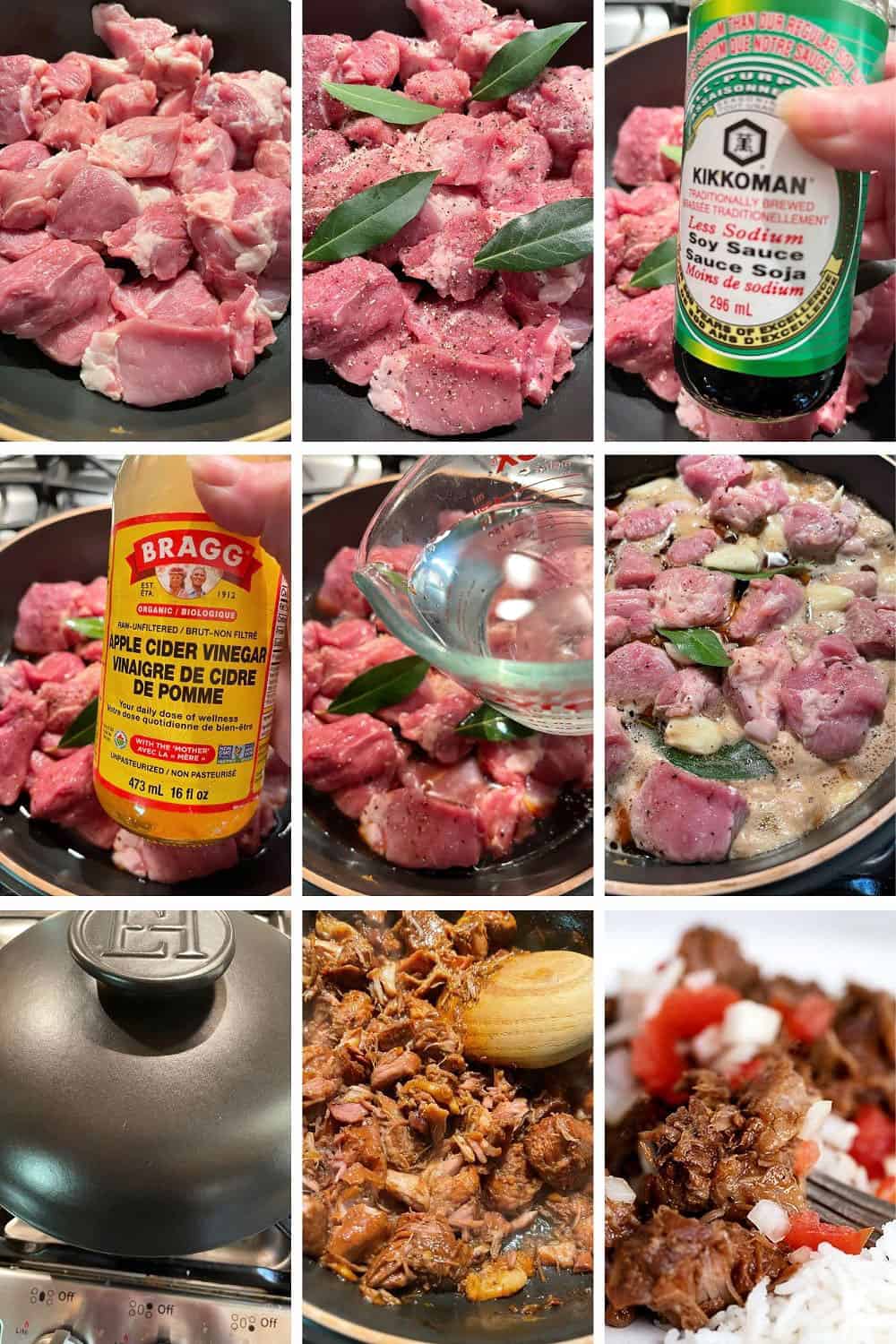
Recipe Video
Recipe tips!
- As noted above, I don’t always pre-cook the pork when starting with pork shoulder. It works just fine without pre-browning. I tend to pre-brown the pork when starting with a pork butt, just to cook off some of the extra fattiness of the pork butt beforehand, which I spoon off and discard.
- You can leave the pork in chunks, as shown in the photos here, or shred it just as you would for pulled pork. Even when left in chunks, the pork pieces are fork tender.
Top tip!
Hide the salt shaker before you start this recipe, so you don’t salt this dish out of habit. Seriously, this dish needs no added salt and low-sodium soy sauce is highly recommended to avoid an overly salty finished dish. If you do all that and you find the dish still a little salty for your taste, you can add an additional Tbsp of brown sugar, to temper it. Also keep in mind that while the pork itself may seem salty, once you combine it with rice or add the garnish, it tends to balance it nicely.
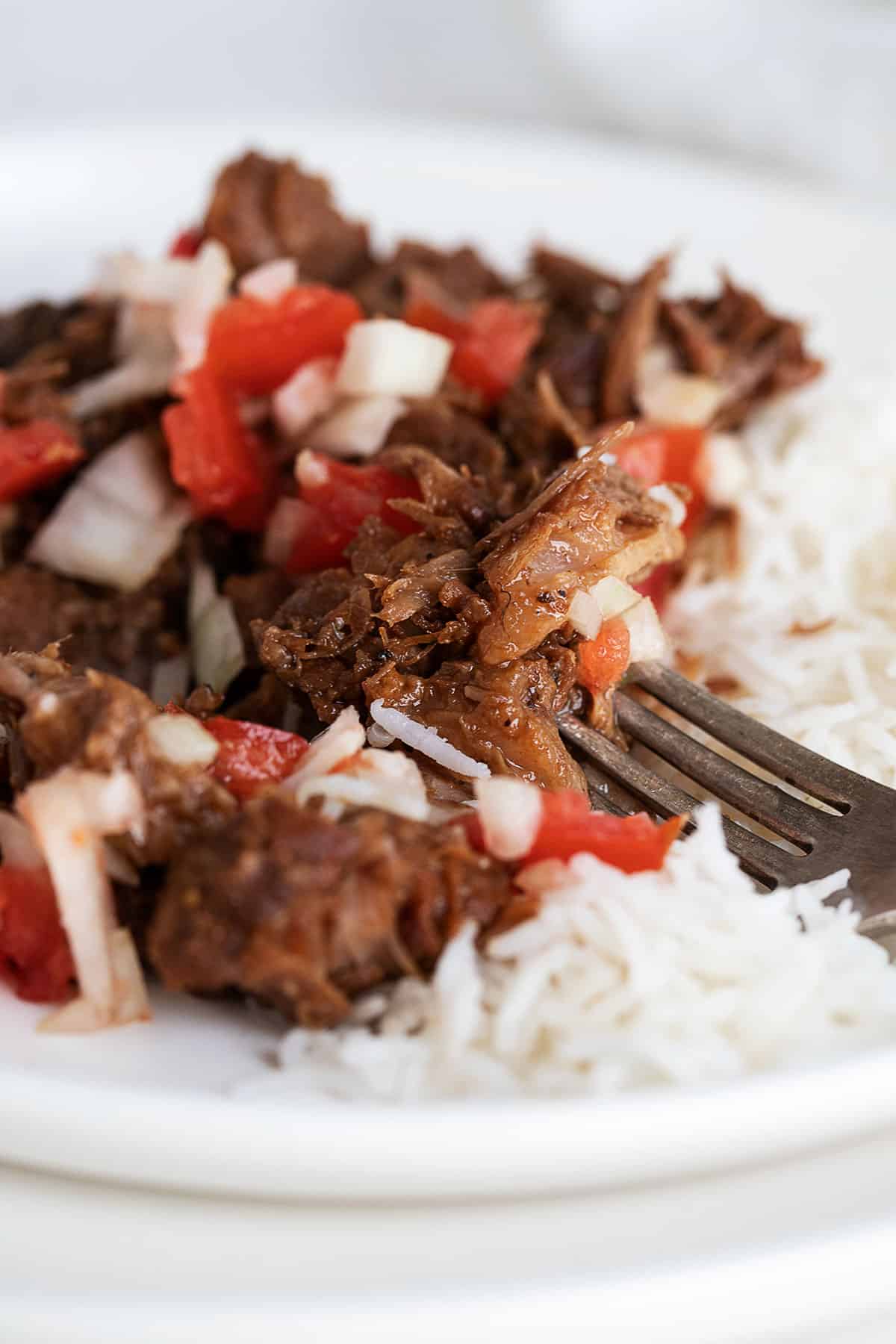
What to serve with Pork Adobo
Most traditionally, pork adobo is garnished simply with chopped fresh tomato and onion (finely chopped and equal parts of each). The freshness nicely complements the salty/sour pork. Beyond that, plain rice is a nice accompaniment or look into Filipino Garlic Fried Rice. While not traditional, I enjoy pork adobo with rustic (my term for mashed potatoes made with the skins left on :), buttery mashed potatoes and a vegetable.
If you want to get untraditional, you can use your pork adobo for tacos, using that same onion/tomato topping. Or treat it like pulled pork and serve it on a toasted bun with some garlic aioli. You can also look up Atsara, which is a traditional Filipino papaya relish, which would add some great flavour to any dish you make with your pork adobo.
Want to save this recipe?
Enter your email and I’ll send it to your inbox. Plus, you’ll get great new recipes from me every week!
By submitting this form, you consent to receive emails from Seasons and Suppers.
You can unsubscribe at any time.
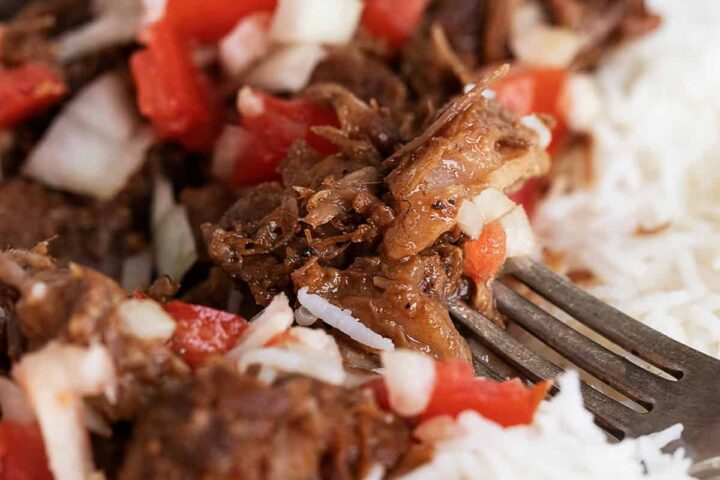
Get the Recipe: Classic Filipino Pork Adobo
Ingredients
- 1 1/2 – 2 lbs pork shoulder or pork butt roast, large pieces of fat and any bone removed *see Note 1
- 6-8 cloves garlic, lightly smashed
- 4 bay leaves
- Coarsely ground black pepper , or smashed whole peppercorns
- 1/3 Cup low-sodium soy sauce
- 1/3 cup distilled white or unfiltered cider vinegar, *see Note 2
- 1 cup water
- 1 Tbsp brown sugar, optional, stirred in at end
Instructions
- Prepare the pork by removing and discarding any large pieces of fat and any bone, then cut the pork into 1 1/2-2” inch pieces. Do not salt the meat!
- Place pork cubes into a heavy-bottom pan/skillet (that has a lid). Add the garlic, bay leaves, pepper, soy sauce, vinegar and water. Do not stir. Bring to a boil over medium-high heat, then reduce heat to medium-low, COVER and let gently simmer for 45 minutes.
- Remove lid and stir. Cook UNCOVERED, for 30-45 minutes, or until most of the liquid has cooked off. Take out and discard the bay leaves. If using, stir in the brown sugar at the end of cooking.
- You can leave the pork in chunks (they will be fork-tender by this point), or break them up/shred. If mixture gets too dry, simply add a splash of water to the pot and stir/warm to loosen.
- Enjoy garnished with chopped fresh tomato and onion (equal parts of each) and served with rice, Filipino Garlic Fried rice or use like pulled pork on a toasted bun, with fresh tomato and onion and perhaps with some garlic aioli.
Notes
- I prefer to use pork shoulder, but pork butt will also work.
- My preference is natural unfiltered cider vinegar (Bragg’s), but. you can use either.
More pork recipes to love!
Hi! I’m Jennifer, a home cook schooled by trial and error and almost 40 years of getting dinner on the table! I love to share my favourite recipes, both old and new, together with lots of tips and tricks to hopefully help make your home cooking enjoyable, stress free, rewarding and of course, delicious!


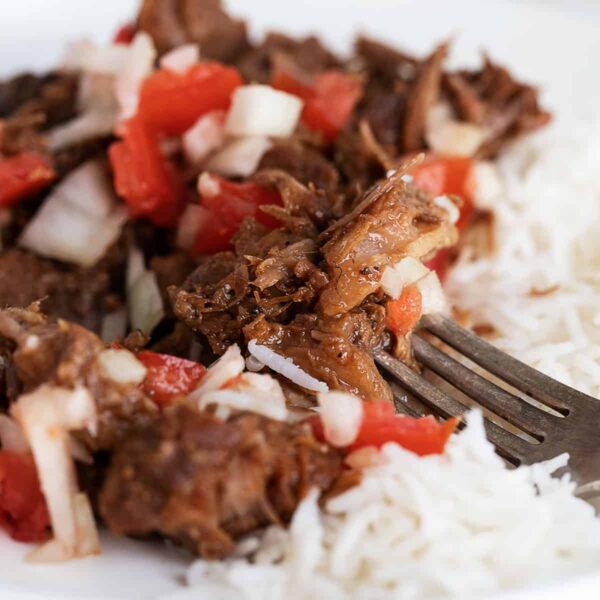
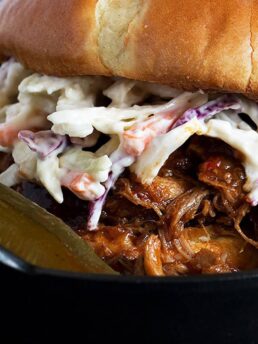
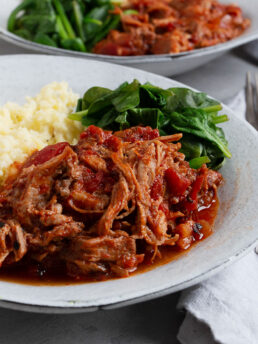
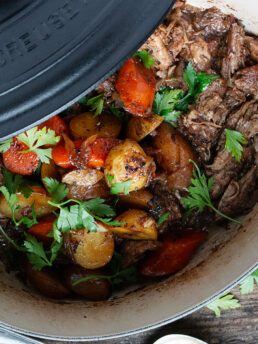

Hi Jennifer,
I’ll be making this recipe later and wondering approximately how much grams is 1 serving? My husband and I are both on a calorie deficit diet and would love to have this recipe in our weekly rotation. Thanks in advance!
Hi Sue, It would be roughly 6oz for a serving.
Thank you so much!! This recipe is delish, I’ll be adding this to our weekly rotation!!
So glad to hear, Sue :) Thanks so much!
Awesome recipe just made it and gone just like that!!! Mahalo and Blessings
So glad you enjoyed it! Thanks so much :)
I don’t have low sodium soya sauce so if I use 1/4 cup of regular soya sauce instead do I also need to reduce the apple cider vinegar in the same amount? I see equal parts of soya and Apple cider vinegar are used. Thanks in advance
I think I would use 1/4 cup regular soy sauce with 1 1/2 Tbsp water and keep the vinegar the same (1/3 cup).
Can I cook it in a slow cooker?
I suppose you could, though you would need to cook off the liquid at the end probably still, which would mean allowing it to simmer with the lid off for about 20-30 minutes or so, or until the liquid is almost gone.
Do you remove the garlic pieces after it’s finished cooking?
Hi Pina, I don’t remove the garlic. They are very mild and almost disintegrated at the end of cooking.
Such an easy recipe Jennifer and sounds right up our alley for game day! Can’t wait to give it a try!
Thanks MaryAnn and yes, perfect for game day!
If I doubled or tripled the recipe what would the cook times be for each size of the roast?
Hi Ellen, since you’ll be cutting the pork into cubes, the cook times should be pretty close to the same, even if you double or triple it. It may take a little longer to cook off the liquid after you take off the lid when increasing the recipe, but probably not much longer. Simply simmer until the liquid is mostly gone, in any case. Enjoy!